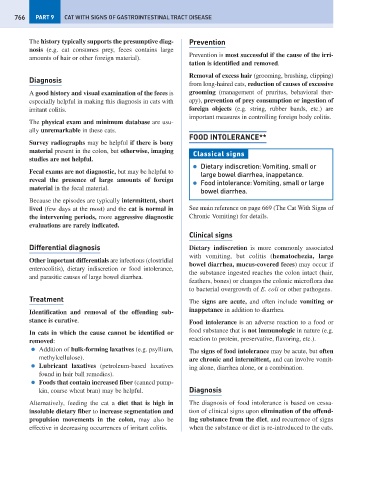Page 774 - Problem-Based Feline Medicine
P. 774
766 PART 9 CAT WITH SIGNS OF GASTROINTESTINAL TRACT DISEASE
The history typically supports the presumptive diag- Prevention
nosis (e.g. cat consumes prey, feces contains large
Prevention is most successful if the cause of the irri-
amounts of hair or other foreign material).
tation is identified and removed.
Removal of excess hair (grooming, brushing, clipping)
Diagnosis
from long-haired cats, reduction of causes of excessive
A good history and visual examination of the feces is grooming (management of pruritus, behavioral ther-
especially helpful in making this diagnosis in cats with apy), prevention of prey consumption or ingestion of
irritant colitis. foreign objects (e.g. string, rubber bands, etc.) are
important measures in controlling foreign body colitis.
The physical exam and minimum database are usu-
ally unremarkable in these cats.
FOOD INTOLERANCE**
Survey radiographs may be helpful if there is bony
material present in the colon, but otherwise, imaging
Classical signs
studies are not helpful.
● Dietary indiscretion: Vomiting, small or
Fecal exams are not diagnostic, but may be helpful to
large bowel diarrhea, inappetance.
reveal the presence of large amounts of foreign
● Food intolerance: Vomiting, small or large
material in the fecal material.
bowel diarrhea.
Because the episodes are typically intermittent, short
lived (few days at the most) and the cat is normal in See main reference on page 669 (The Cat With Signs of
the intervening periods, more aggressive diagnostic Chronic Vomiting) for details.
evaluations are rarely indicated.
Clinical signs
Differential diagnosis Dietary indiscretion is more commonly associated
with vomiting, but colitis (hematochezia, large
Other important differentials are infectious (clostridial
bowel diarrhea, mucus-covered feces) may occur if
enterocolitis), dietary indiscretion or food intolerance,
the substance ingested reaches the colon intact (hair,
and parasitic causes of large bowel diarrhea.
feathers, bones) or changes the colonic microflora due
to bacterial overgrowth of E. coli or other pathogens.
Treatment The signs are acute, and often include vomiting or
inappetance in addition to diarrhea.
Identification and removal of the offending sub-
stance is curative. Food intolerance is an adverse reaction to a food or
food substance that is not immunologic in nature (e.g.
In cats in which the cause cannot be identified or
reaction to protein, preservative, flavoring, etc.).
removed:
● Addition of bulk-forming laxatives (e.g. psyllium, The signs of food intolerance may be acute, but often
methylcellulose). are chronic and intermittent, and can involve vomit-
● Lubricant laxatives (petroleum-based laxatives ing alone, diarrhea alone, or a combination.
found in hair ball remedies).
● Foods that contain increased fiber (canned pump-
kin, coarse wheat bran) may be helpful. Diagnosis
Alternatively, feeding the cat a diet that is high in The diagnosis of food intolerance is based on cessa-
insoluble dietary fiber to increase segmentation and tion of clinical signs upon elimination of the offend-
propulsion movements in the colon, may also be ing substance from the diet, and recurrence of signs
effective in decreasing occurrences of irritant colitis. when the substance or diet is re-introduced to the cats.

